132 Pairs of White Shoes Were a Sobering Reminder of Lives Lost to Traffic Violence
7:06 PM CST on November 19, 2018
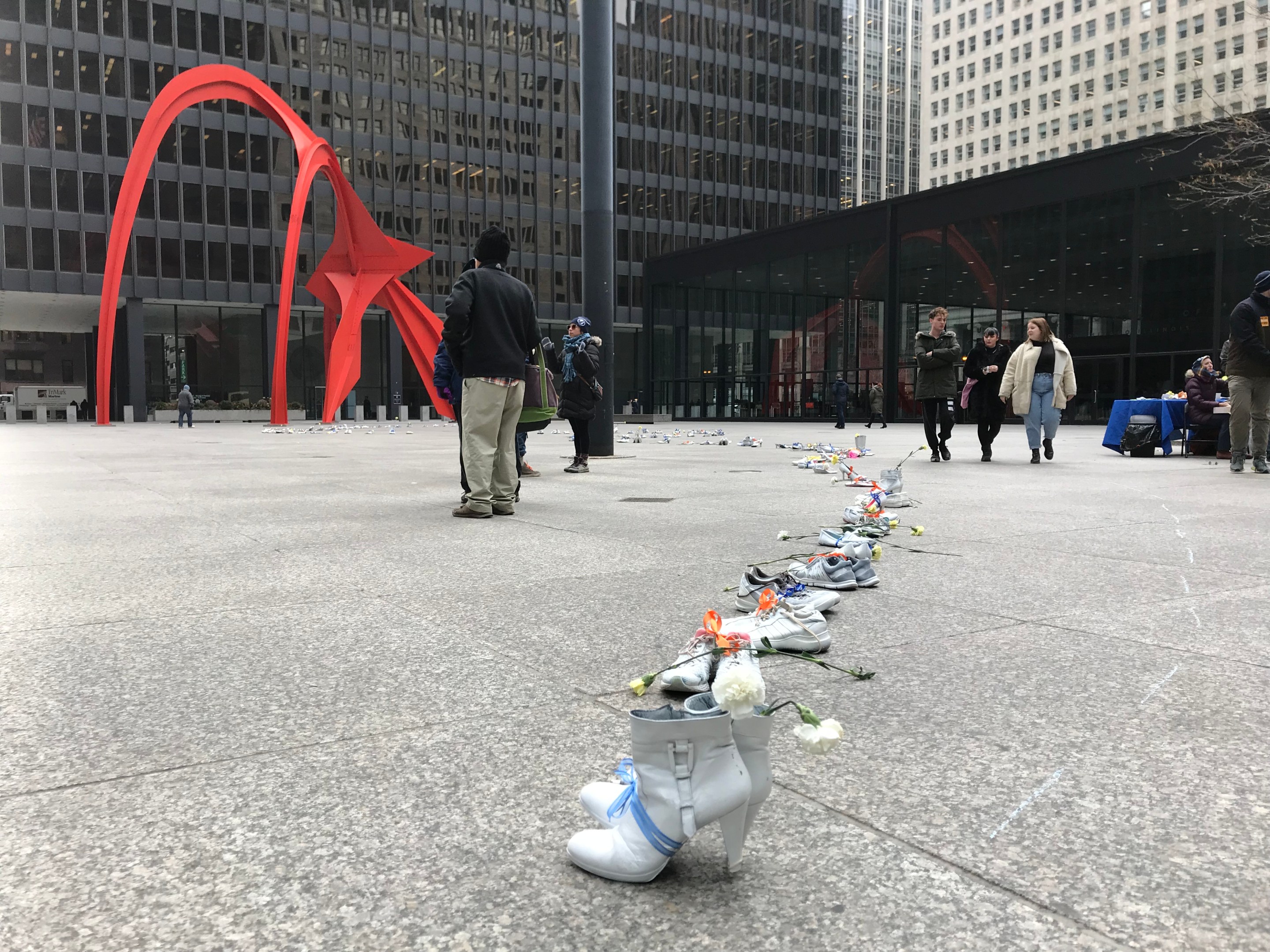
The 132 pairs of white-painted shoes in Federal Plaza. Photo: John Greenfield
For many years fallen cyclists have been honored by the installation of white-painted “ghost bikes” at crash sites in Chicago and around the world. On Sunday 132 white-painted pairs of shoes were placed in our city’s Federal Plaza as a memorial to all 132 people killed in collisions on our city streets in 2017, as part of World Day of Remembrance for Road Traffic Victims.
The shoes formed a long, serpentine trail on the granite plaza, below Alexander Calder’s orange “Flamingo" Sculpture. Blue ribbons on the footwear symbolize motorists who died, orange ribbons represent people who were walking when they were struck, and yellow ribbons commemorate people who were biking. The installation was done by staff from the Chicago Department of Transportation, which is spearheading the city’s Vision Zero Chicago crash prevention efforts.
Family and friends of victims were invited to place flowers and mementos of their loved ones at the plaza on Sunday. This morning there was a press conference where survivors were joined by city and state leaders, who pledged to do their part to create safer streets and prevent future tragedies. CDOT Commissioner Rebekah Scheinfeld began the event by requesting a moment of silence from the several dozen people who had showed up to the plaza.
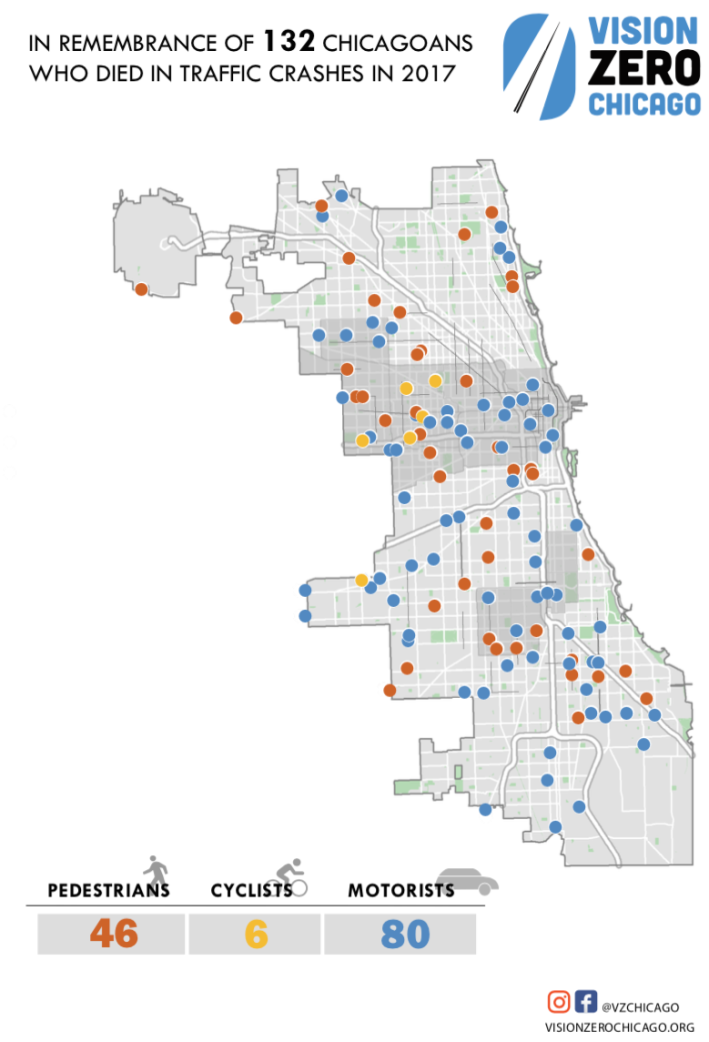
“To crash survivors and those who have lost loved ones, we hold you in our hearts and we recognize that a traffic crash is not an accident,” Scheinfeld said afterwards. “It is a sudden, violent, and traumatic occurrence that affects not just the people in the crash but also their communities and wider society for years to come. These are incidents that can and must be prevented.” She noted that every day five people are seriously injured in collisions in our city, and every three days someone dies. That’s more than 2,000 people seriously injured or killed each year.
Next Scheinfeld discussed what the city has done so far to reduce crashes as part of its Vision Zero effort to eliminate serious and fatal traffic injuries by 2026. She stated that outreach workers have discussed traffic safety with 115,000 residents at hundreds of events, with a focus on high-crash areas on the West Side. She noted that last year the city passed an ordinance requiring side guards -- devices that help keep pedestrians and cyclists from being crushed under the wheels of a vehicle -- on some large trucks operating within the city. And she said CDOT is in the process of completing 300 pedestrian safety projects, such as sidewalk extensions and pedestrian islands, by the end of the year.
Julie Morita, commissioner of the Chicago Department of Public Health, spoke next, emphasizing the fact that traffic crashes aren’t just a transportation issue, but also a major public health problem. She said her department is committed to working with stakeholders to help create a safer transportation system, which will save lives and prevent life-altering injuries.
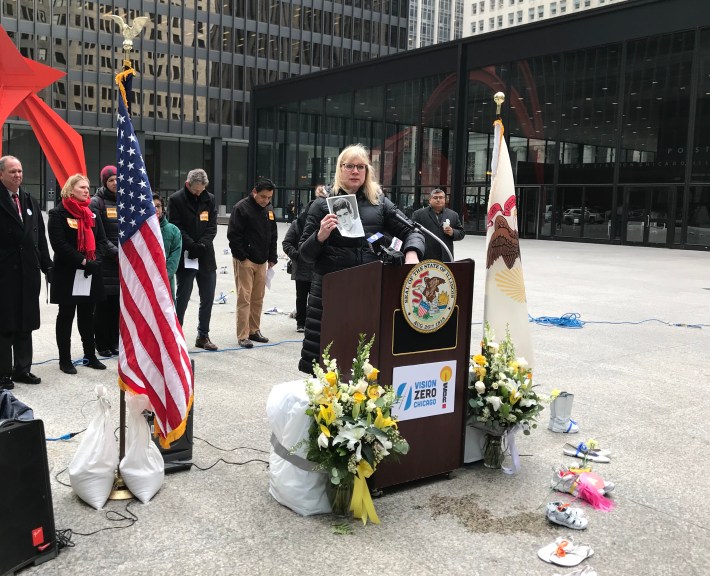
After that Janna Henning, a professor of clinical psychology at nearby Adler University, spoke about her experience losing her partner Patrick Stack to a fatal bike crash in 1989, just before his 27th birthday, a tragedy that still haunts her three decades later. Henning described Stack as “intelligent, articulate, funny young man who was passionately interested in theater and improv, history, and his hobby, astrology,” adding that “he was also deeply loyal to the people he loved, and fiercely protective of their safety and well-being.”
Stack was cycling home from his job at a graphic design firm, where he did bike deliveries as well as design work, when a truck driver struck him at the corner of Huron and Orleans. A ghost bike was installed at the site in 2011.
“Almost 30 years later, there isn’t a day when he doesn’t come to my mind,” Henning said. “I wonder what my life would have been like if I hadn’t had to find a way to cope, at the age of 27, with the sudden loss of the person whom I loved best, and who was always 100 percent for me, and in my corner.” She added that Stack wanted to become a teacher, and she thought of all the potential that was wasted by his death, the students he might have educated, and the children and grandkids he might have had.
Henning noted that that she has been able to find meaning in life after losing her partner by becoming a psychologist who specializes in teaching and providing therapy concerning traumatic stress and death and dying. “It’s not a coincidence that I have put my energy and passion into this type of work, and in this way some good has certainly come out of Patrick’s death. In a sense, I honor him every day through my work,” she said.
But she added that “Patrick’s death profoundly impacted many people, and he will be remembered and mourned for the rest of our lives. So please, let’s all work to prevent traffic [crashes], so others won’t have to grieve as we do.”
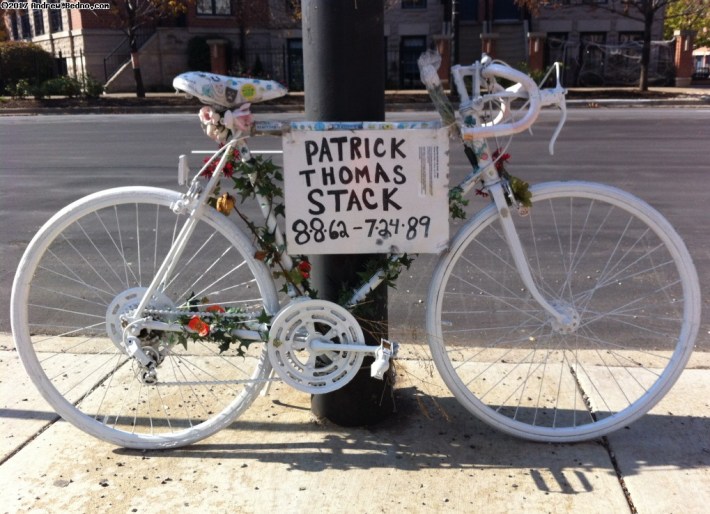
Next Rosanna Márquez, state president of AARP Illinois, noted that while people 50 and over only make up about 13 percent of the population, more than half of the 45 pedestrians struck and killed in Chicago in 2017 and the 38 fatally struck so far in 2018 have been in that age bracket.
Márquez noted that AARP gave the city of Chicago a $30,000 challenge grant to design and build a “People Spot” on-street seating area, which debuted in Chatham earlier this month. She said the facility not only helps make the street more welcoming to pedestrians, it also makes it safer by encouraging drivers to slow down while making turns.
She knows the dangers posed by fast-turning drivers firsthand, because in 2002 a driver whipped around the corner of Jackson and Clark when she was crossing the street in the crosswalk with a walk signal, striking her and throwing her into the air. She recalled her thoughts during the few seconds she was aloft. ‘“Oh my God, I’m in the air. Am I going to land on the windshield of this car, am I going to get thrown into oncoming traffic coming down Jackson? Am I going to die?’”
While she survived, she suffered severe injuries to her right leg and had to undergo several reconstructive surgeries, including the removal of part of a muscle and the installation of a titanium rod. “So I have a number of physical reminders, but maybe more important I have the mental reminders.”
“I was doing everything right,” Márquez noted. “Our numbers tell us as well that of those who are hurt or killed in pedestrian crashes in Chicago, the majority were, as I was, doing everything right.”
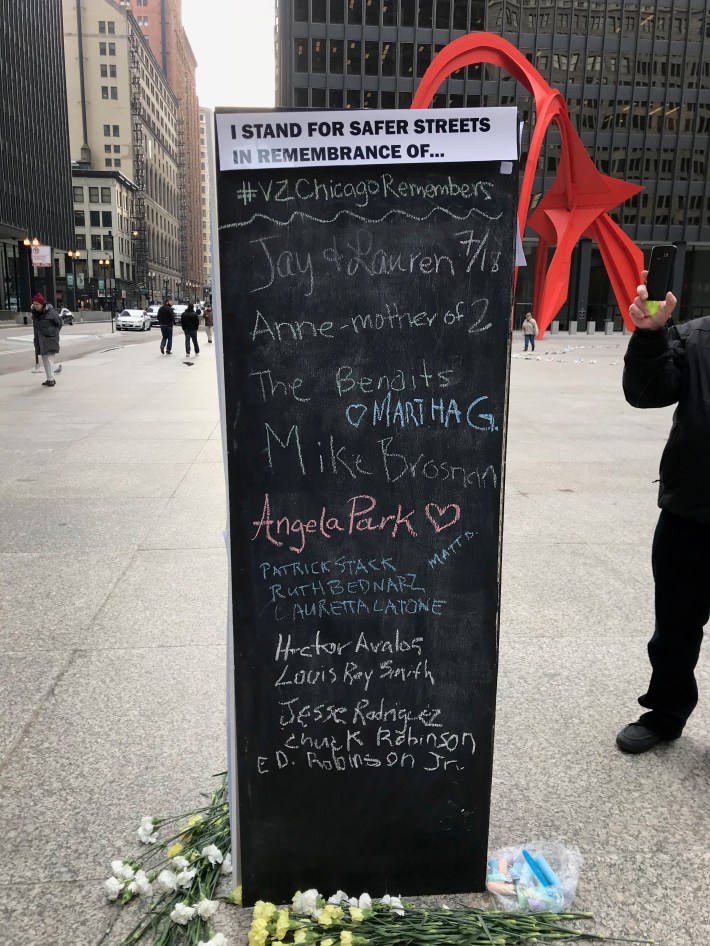
Next Mike Tomas of the Garfield Park Community Council, one CDOT’s partners on the West Side Vision Zero initiative, spoke to the crowd. “Personally I’ve lost several friends to traffic crashes,” he said, addressing the families and friends of victims. “I’m here to let you know that you’re not going through this alone. We are all here to help. We acknowledge that traffic deaths are preventable and unacceptable… Victims need to know that lessons are being learned and your loved ones did not die in vain.”
After that Active Transportation Alliance director Ron Burke argued that not enough attention is devoted to preventing traffic injuries and crashes in the U.S. “Too often we ignore or accept traffic crashes, even though the number of victims is truly staggering,” he said. “About 100 Americans per day die in traffic crashes.” He stated that in the past two-and-a-half hours more Americans had died in traffic crashes (on average about ten) than have died in commercial airplane crashes in the past decade.
Burke credited CDOT and the Illinois Department of Transportation for taking steps to address the problem, but asserted that more needs to be done to create safer design, slow down cars, and reduce the amount of driving overall. “Because we all know that the fundamental ingredient that goes into most traffic crashes is that car, that 3,000 pound vehicle that’s ramming into people and causing these horrible fatalities and injuries. We need to prioritize alternatives to driving, so that we have fewer cars in the streets to begin with.”
He noted that traffic violence disproportionately affects low-income communities. “People who are least able to deal with these tragedies are often the ones most likely to be hurt, injured, and killed.”
As such, Active Trans is currently asking mayoral candidates to endorse its proposal to earmark $20 million annually for a “Bike Walk Fund” for safety infrastructure, which would be focused on underserved communities. The group is also planning to talk to state legislators and governor-elect J.B. Pritzker about earmarking $50 million a year for a state Bike Walk Fund.
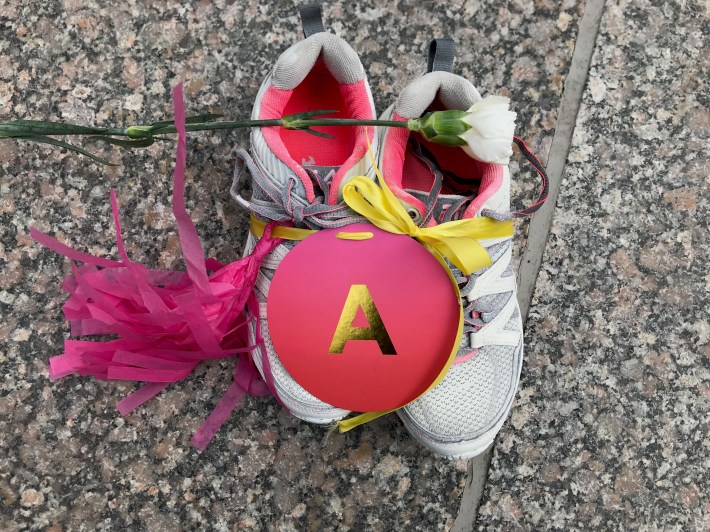
Finally, IDOT secretary Randy Blankenhorn told the crowd that Illinois has seen over 1,000 deaths on its roads for the past two years. “That’s a number that is simply unacceptable to us and it needs to be unacceptable to you… They’re not numbers, they’re people.”
Blankenhorn added that because most of these fatalities were preventable, “it gives us home that we can turn the tide and do things differently and make a difference in people’s lives.” He said a new task force on crash prevention at state level includes “nontraditional people,” not the just traffic engineers and other state employees who normally make the decisions about road design.
He said IDOT’s version of Vision Zero, called Toward Zero Deaths, includes some outside-the-box strategies to change driver behavior. Recently the changeable “dynamic message signs” on highways have featured sobering statistics about crashes, as well as memorable, often humorous, safety reminders – think “No speeding, no texting, no ketchup.” And the department has been placing totaled vehicles from crashes at downstate rest stops to get people talking about how they got that way.
After the ceremony, Janna Henning said she thought the installation in the plaza was an good strategy for raising awareness of the need for safer streets. “It’s a powerful visual, because when you see that many shoes you think of those people," she said. "The white paint highlights the idea that these people are not here any longer. What makes me a little bit sad is all the cars going by and honking, and people might walk by without knowing what this is about. It’s such a great metaphor for how little attention is paid to this issue and to the deaths that occur, and the fact that we really need to publicize this issue a lot more.”
This post is made possible by a grant from the Illinois Bicycle Lawyers at Keating Law Offices, P.C., a Chicago, Illinois law firm committed to representing pedestrians and cyclists. The content is Streetsblog Chicago's own, and Keating Law Offices neither endorses the content nor exercises any editorial control.
In addition to editing Streetsblog Chicago, John writes about transportation and other topics for additional local publications. A Chicagoan since 1989, he enjoys exploring the city on foot, bike, bus, and 'L' train.
Stay in touch
Sign up for our free newsletter
More from Streetsblog Chicago
Which Metra corridor would become more bike-friendly and greener under a new plan? Ravenswood!
Thanks to plans to convert little-used parking spaces, the avenue is slated to get a new bike lane, and the Winnslie Parkway path and garden will be extended south.
They can drive 25: At committee meeting residents, panelist support lowering Chicago’s default speed limit
While there's no ordinance yet, the next steps are to draft one, take a committee vote and, if it passes, put it before the full City Council.
One agency to rule them all: Advocates are cautiously optimistic about proposed bill to combine the 4 Chicago area transit bureaus
The Active Transportation Alliance, Commuters Take Action, and Equiticity weigh in on the proposed legislation.



